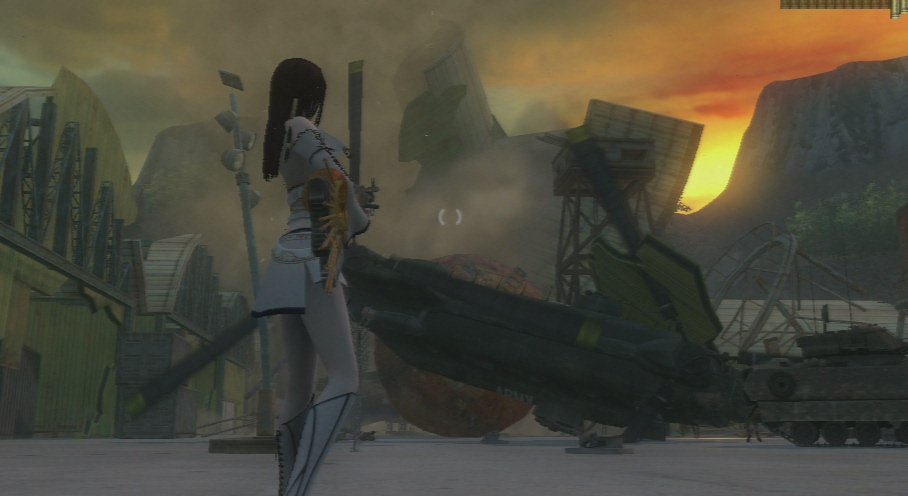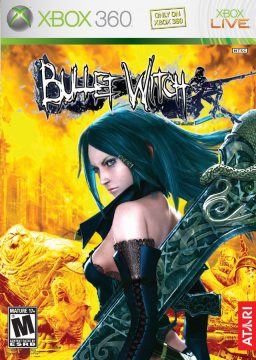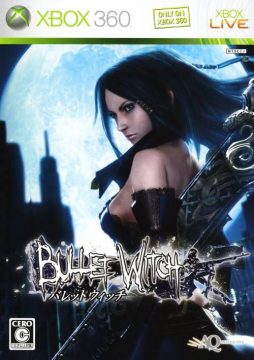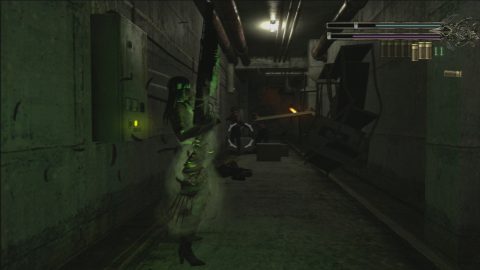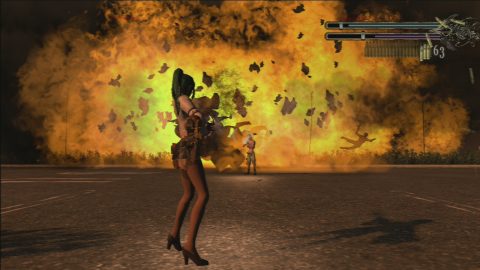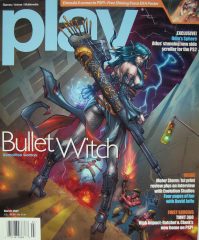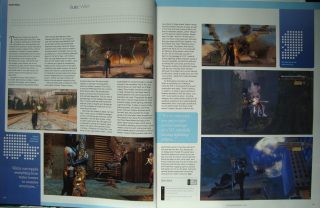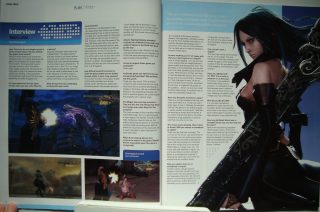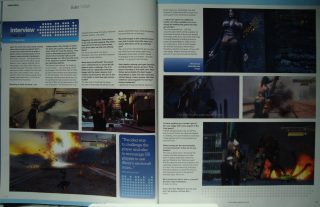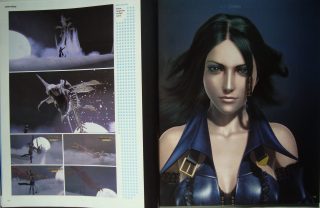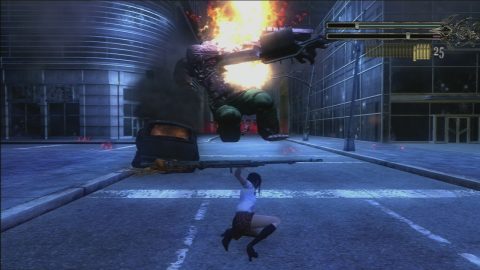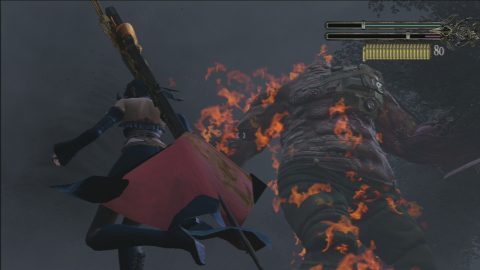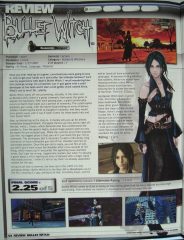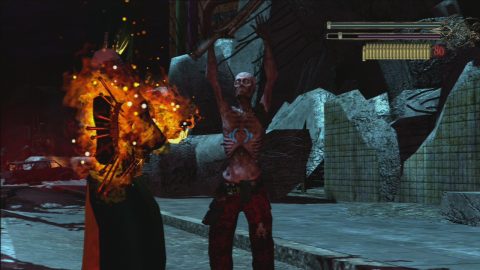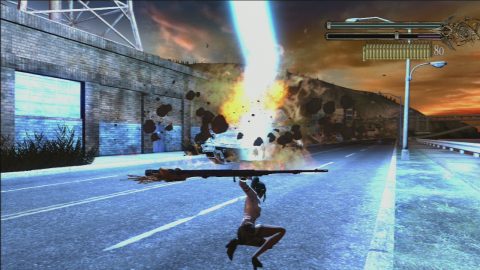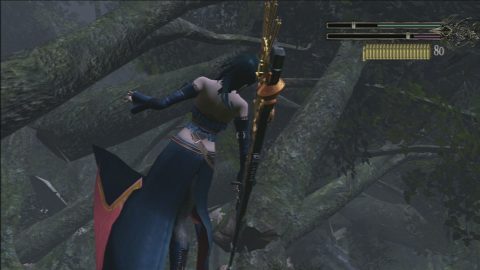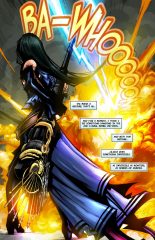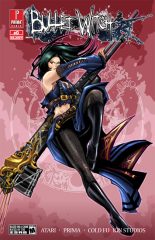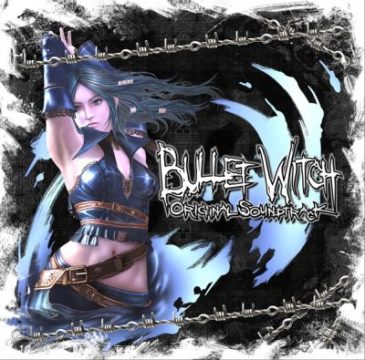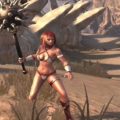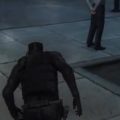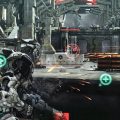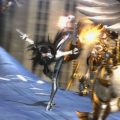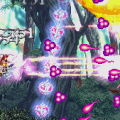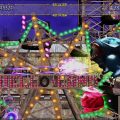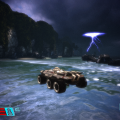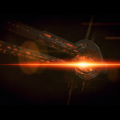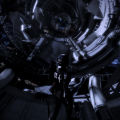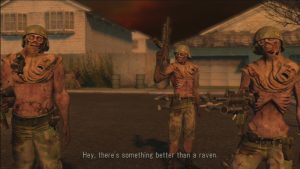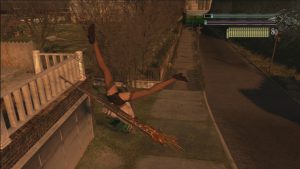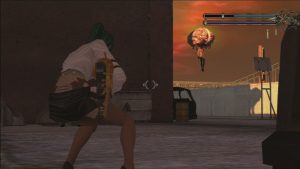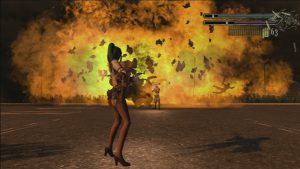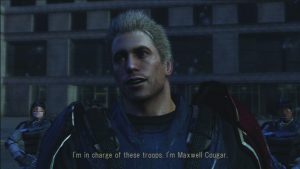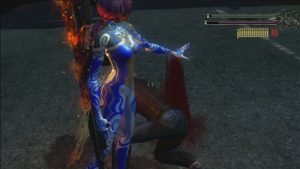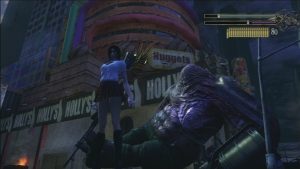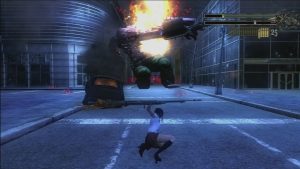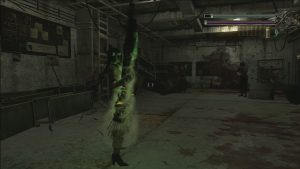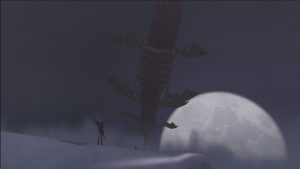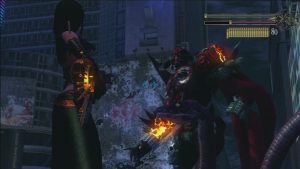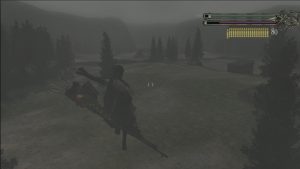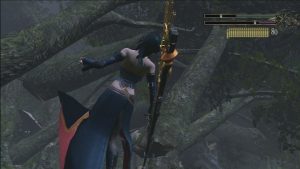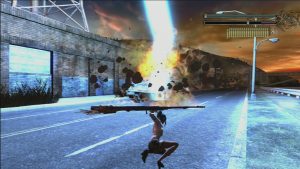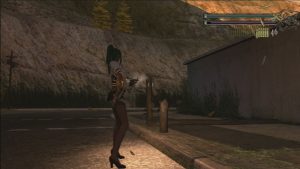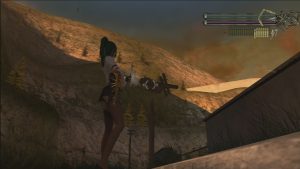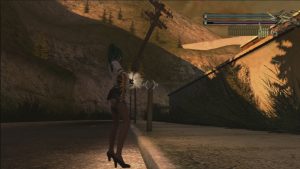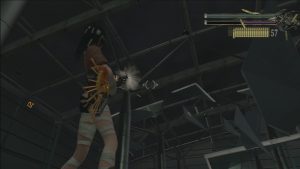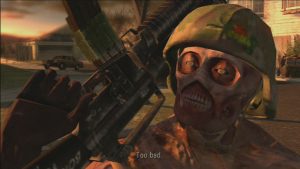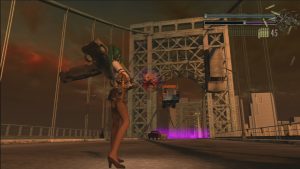The Xbox 360 launched in various international territories in the final weeks of 2005, and roughly six months later Bullet Witch was released in Japan. As everyone knows, launch titles and those which come out soon after seldom showcase what new hardware is capable of, and they rarely age well. Although this is the case for Bullet Witch, it’s not easy to articulate. Or perhaps, rather, it’s too easy to dismiss it without really thinking about it. While there are plenty of quantifiable reasons to describe the game as “bad”, it’s still possible to find a certain charm to proceedings.
There are some fantastic ideas and highly enjoyable set-pieces – which are unfortunately marred by some truly awful ideas, which are so bad it’s miraculous they were even implemented, let alone managed to stay with the game throughout development and quality control. Poor design choices even managed to linger after the game was allegedly given six additional months of development prior to its Western release by Atari, by which time it should have been obvious what needed correcting. Almost nothing seems to have changed though, and the tragic irony is that the Western release is demonstrably worse than the Japanese original. Despite the list of problems, there are moments of fun, showing that developers Cavia at least had the start of something good. The company’s past experience working on Ghost in the Shell: Stand Alone Complex (2004) for PS2, which was fantastic, should have helped them. And despite the extremely vocal critics who despise Bullet Witch, there are those who are open fans (even if they only admit to it being a guilty pleasure) and have attained all of its Achievements. Even so, in the subsequent years since its release it’s been surpassed by other, similar games, all of a higher quality, and all of which highlight how batshit ridiculous some of Bullet Witch‘s problems are.
Cavia is a fascinating company, full of oddities and maverick sensibilities, which sadly went bankrupt after Nier, and Bullet Witch stands as interesting point in their history. If we’re being honest it’s genuinely not a good game, but for the low price it now has, it can be strangely captivating. In a way it exemplifies the problem of perception and value with retail games, because for $5 it’s worth dissecting.
Not quite a shooter
The premise is that in the near future some madman archaeologist opens an already existing portal to hell in order to make a deal with the devil which revives his deceased beloved. Of course endless waves of demons pour out and the human race almost becomes extinct. Cue Alicia Claus, a sexy young witch with an enormous gunrod instead of a broom and a demon inside of her, hellbent on eradicating the evil plaguing mankind. Along the way she’s helped by soldier man Maxwell Cougar – “I’ll never get used to seeing a buddy die!” The story isn’t important because this is a fast-paced third-person shooter. Or is it…?
Alicia has four main guns at her disposal – initially just a machine gun, with a shotgun, sniper rifle and Vulcan cannon unlockable as you progress. The first thing everyone notices, and which was raised by pretty much every reviewer, is the delay when raising your weapon to fire. It takes roughly a full second for Alicia to unholster her “gunrod” before firing. Once out it stays active when shooting, and remains active for a short time, after which she puts it back. This creates an extremely bizarre and frustrating tempo to the gameplay. A good shooter, whether first- or third-person, is anchored in the reflexes of the player, and relies on immediate activation of weapons. Any kind of controller lag is enough to kill it for most players. So why the excruciating animation delay inBullet Witch? It’s feasible that you could create a shooter based on delays, methodical timing and anticipation, but Bullet Witch is designed and structured like something fast paced. What makes it even more strange, is that the game can be played with your gun constantly at the ready – clicking in the right stick changes the camera angle slightly, and readies the weapon. Alicia will never put it away, unfortunately it’s impossible to play like this due to the entire screen being obscured by her rather lovely bottom. The alternative is to regularly tap the fire button, thereby cancelling the “put back” animation. Ammo is infinite so this isn’t a problem, but still – why force players to do this? On higher difficulties the game is almost impossible, since this delay means the difference between cancelling an enemy’s attack and getting killed.
Play Magazine – Cover and Review
The timing for everything, in fact, is jarring. That includes the nine magic spells you can cast: Rose Spear flings a rose, causing spikes to erupt from the ground where it lands, impaling enemies; Willpower flings any nearby object outward like a telekinetic missile; Ancient Wall creates a protective barrier in front of Alicia; Raven’s Panic sends out ravens that stun nearby enemies; Element Shot empowers the current chosen gunrod with a unique power; Sacrifice causes blood to squirt from Alicia’s wrists, healing an injured NPC; and finally there are three super powerful, screen destroying area attacks, suitably named Thunder, Tornado and Meteor. Much like the gunrods, the timing to these is weird. Sacrifice freezes Alicia in place while she heals an NPC, but she can still take damage and quite often will get killed if there’s a nearby enemy. Rose Spear takes so long to activate after throwing it that any clustered enemies have moved away, making it utterly useless. Element Shot has its own annoying animation routine you need to watch, and once activated only the machine gun’s fiery bullets are any good. The most frustrating spells are the super magic attacks. After activating Thunder you get a mini-cutscene, followed by a period of immobility where you need to re-aim at the enemy you wanted to attack and fire again, whereupon another cut-scene takes over before the enemy is hit. If he moves at any time during the two cutscenes or your aiming period, too bad. And if you get hit during the second aiming, it’ll all cancel. There’s very little immediacy to your actions, whereas the damage the enemy deals to you is very immediate. Having said that, Willpower activates instantly, and it never grows old flinging garbage through the air to crush enemies.
Bullet Witch desperately wants to be Gungrave (2002), with acrobatic leaping, visually appealing violence and spectacle, plus powerful super attacks finished with a little pose. But Bullet Witch can’t really match it – Gungrave allowed immediate action, with instant projectiles the moment the fire button was pressed. Holding it down meanwhile resulted in a series of attacks accompanied to break dancing. You could also perform incredible dives and jumps, all while directing your gunshots as if in a John Woo film. Bullet Witch allows the acrobatic jumping and diving, but your gun is immobile throughout, unable to fire a single shot. Why can’t you shoot while jumping? Why the animation delay? It’s unfortunate, because the two games share other positive traits. Both focus on pure action, without any item pick-ups to dilute proceedings. Dave Halverson in Play magazine made an excellent point when stating there are no trinkets to collect in Bullet Witch. There’s no 100 broom bristles which unlock something, there’s not even power-ups. Your health and magic constantly recharge and ammo is infinite, allowing you to focus on the good stuff. It’s pure, undiluted blasting… Apart from the enormous empty environments where nothing happens. Which is another thing Gungrave got so right – it constantly funnels you to the next action set-piece so you’re never bored. It’s maybe a little linear, but the relentless nature works so, so well.
The criticisms with Bullet Witch though, aren’t simply that it’s not Gungrave. As you’ll see, there’s a long list of similar-but-better games. Most notably Cavia’s own Ghost in the Shell: Stand Alone Complex, which was by the exact same internal development team, as stated by Cavia in an interview with Play magazine. What’s strange is how Bullet Witch, a new IP without any restrictions from a license holder, managed to be a step back from Stand Alone Complex. Both games feature the same jumping summersaults – hell, Bullet Witch might even be using the exact same animation routines. The big difference is that during normal jumps you can shoot in Stand Alone Complex. Otherwise both feature gunplay with massive ammunition clips, and both have melee attacks, except that it’s much, much better in Stand Alone Complex, with a little slow-motion cinematic finish. The level design and structure is also more interesting in Stand Alone Complex: although it lacks physics it’s more interactive, with scaleable heights to navigate, plus the ability to hack into and control enemies. There’s a lot of clever structural design. The shooting is also instant, since your character always holds their gun at the ready. Hilariously, both games even feature the same style of annoying sniper, with a little red laser homing in your character to deal an instant kill. It’s clear that Stand Alone Complex was Cavia at its best – a big publisher behind them, a fantastic license to work from, plus lots of money and resources to really go to town. For whatever reason Bullet Witch went off in a strange direction and never recovered.
It’s abundantly clear that Cavia just went off on one, throwing in whatever seemed good – and the interview with Play magazine attests to this. It’s almost beautiful how some of the game’s clever ideas actually coagulate into major flaws. Take magic recharging, for example. Your magic constantly recharges. So to stop players hiding behind corners and then popping out to spam the strongest spells, every time you use magic the meter’s maximum level depletes slightly. Until you’re left with just a tiny fraction of potential magic. The only way to build it up is to kill the Geist soldiers with physical attacks, whereupon the potential maximum increases and – once the bar is at its longest and fully charged – you can cast screen destroying spells again. Except some idiot thought it would be a good idea to require magic when reloading your guns (it just depletes the magic, not the maximum potential). Presumably it’s to foster tactical play when reloading and casting. In the hands of a skilled developer like Treasure this could have worked… Here though, if you cast a super powerful spell and forgot to reload before doing so, you’ll be running around without any magic to actually reload the weapons needed to perform the physical attacks needed to recharge the magic you don’t have. Oops! Luckily there’s a melee attack; unfortunately it’s extremely difficult to connect with.
Some things aren’t that bad
Unfortunately, once a game starts down a bad path, reviewers are inclined to criticise everything, whether it warrants it or not, and even if there is genuine merit to the madness.
Almost every critic complained about the visuals – what they fail to mention is, everything is interactive. It’s not a sterile plastic corridor of pretty facades which can’t be affected, but a dirty, pliable toybox based on some fairly impressive physics. The Willpower magic can hurtle any vehicle or nearby detritus away and into the air, damaging anything it touches. This is incredibly fun to pull off. Fling a car and everything that it hit scatters. Shoot the telegraph poles and they break at different points. Blast the roof in a cave or tunnel, and it’ll crash down burying enemies. You can also bring a glass ceiling at the airport cascading down with a few shots. Compare this to something like Deus Ex: Human Evolution, which looks nicer but where you can unload an entire machine gun into a shelf of test tubes and none of them break.
Hardcore Gamer Magazine – April 2007
This really needs to be addressed: there is a sliding scale determined by budget, development time and staff numbers, which veers between graphical quality and the interactivity of environments. Critics who claim to prefer pretty visuals over the ability to destroy almost anything are making a mistake. It’s tremendously satisfying to come to a wooden building and obliterate it with gunfire or powerful magic. Using the “shotgun wind” magic, a single blast will send everything flying. And breaking stuff in Bullet Witch isn’t mere window dressing, it is integral to gameplay, adding depth, since every part of the environment can become a weapon when flung at an enemy. Likewise, the environment can suddenly come alive due to psychic telekinetic enemies, killing you instantly. Actually, thinking about it, that can be extremely annoying – though the terror of seeing a psychic enemy lift half a dozen cars ready to crush you does have its merits.
Having said all that, according to Cavia in interviews they had over 100 staff (if you include the outsourcing) and they worked on the game for two years. So it should have looked a bit slicker. Also, the ability to bring down entire cities with real-time environmental damage was already going strong on the Xbox with Otogi (2002) and on PS2, with games like Chikyuu Boueigun (2003). In both cases it was also much easier to actually destroy the environment, since you can only do it in Bullet Witch when using the most powerful spells. Furthermore, Otogi and its sequel on Xbox both look much better than Bullet Witch, despite predating it by several years and existing on older SD hardware.
The game looks good enough though, and the art direction is… Shall we say, interesting? The enemy designs, such as the Geist soldiers wearing human skin, are awesome. The demon boss from level three, consisting of an elongated skeleton filled with flesh and eyeballs, is something that conceivably could be straight out of hell. Actually, it’s worth describing in detail, since this is arguably one of the greatest boss fights in the history of video games. After everyone escapes from an airport aboard two aeroplanes, they’re attacked by said demon. So Alicia blasts a hole in the side of her aircraft, and leaps onto the roof of the other to take on the beast. The plane rolls from side to side, so you need to be careful, all while shooting away giant eyeballs which attack the plane trying to bring it down. Once your magic meter is charged to maximum, it’s time to unleash thunder upon the demon. It really is as fantastic as it sounds, with an impossibly huge enemy to contend with, plenty of small fodder to boost your magic, and a tremendously epic atmosphere. This alone is almost worth the $5 admission. Meanwhile, does anything really need to be said about these freaky penis monsters? They shoot out swarms of pale ghost-heads, complete with ethereal spermatozoa tails, that fly towards humans and burrow into their skull to create one of the most disturbing, warbling enemies ever seen a videogame.
The spell wheel also isn’t anywhere near as problematic as critics have made out. You bring up one of three spell wheels with LB and RB, cycling through them, then use the face buttons to activate the desired spell. Most reviewers seemed to need to read the name of each spell, each time. After a little playing it actually becomes easy and – dare I say it – even intuitive. Given how many gamers took to Bayonetta‘s extremely convoluted dial-in combos, some being eight or more button presses long, the maximum of four button presses for spells isn’t difficult at all here. Lightning is RB, RB, RB, A, whereas the Rose Petal attack is RB followed by X. There’s only nine spells in the entire game, and they’re acquired gradually, so you learn as you go.
Why are you doing that?!
While a lot of the criticisms can be brushed aside, and others ignored due to the fun to be had, there are some which again make no sense as to why they weren’t addressed.
Major problem: it needs a map, and a compass, desperately. Even Oneechanbara: Bikini Samurai Squad, (2006) another unusual game with a varied reputation which predates Bullet Witch, included a map and was all the better for it. The counter argument is that if you’re trying to explore in Bullet Witch, you’re playing it wrong. You should just follow the trail of enemies, since that’s where the action is. Which is fine, except there are a lot of branching paths to nowhere, and in the second stage there’s an enormous area with several powerful enemies to kill, each hidden away in obtuse parts of the map. Two are down a hidden side alley, close to each other, while the third is only accessible by leaping onto a narrow pathway near the side of a building – which in most other games would be inaccessible due to an invisible wall. It’s interesting that Cavia would make it so counter intuitive, but in practice it just means lots of running around.
It also has a similar leveling problem as seen in Project Sylpheed. After completing each stage you’re given skill points, based on your grading for that level, to spend on HP, MP, your weapons and spells. But you only earn enough to upgrade one or maybe two at a time, meaning you’ve got about six or maybe seven opportunities if you’re especially skilled. But you can see the problem, can’t you? If you’re not very good, maybe you can only upgrade four times, meaning that by the end you’ll be doing even worse due to not having enough upgrades. Or perhaps you chose to upgrade the wrong ability! Chances are most players won’t even be able to unlock the Vulcan cannon until their second playthrough. It’s hugely frustrating, with no recourse if you screw up. Why so many developers choose to implement this type of design is baffling – if you’re allowing technical improvement based on displayed skill, the weak will only get weaker and find the game more difficult, while the skilled will become increasingly more powerful and find it too easy. It rewards no one. For your first playthrough: make sure to play on Easy Mode. More difficult modes are only unlocked by completing all three initial modes, and you’ll be thankful of the extra leveling gained from Easy when you go to tackle Normal. There’s a separate achievement anyway and the EXP carries over.
Even on easy though, the game can be extremely difficult. As mentioned it features the same red-laser snipers from Stand Alone Complex, where one graze instantly kills you. Being touched by flying debris also instantly kills you. One variety of enemy is a floating brain, called a Walnut Head, which levitates all surrounding objects to throw at you – instant game over if you don’t avoid them. Bullets from the giant enemies will also quickly kill you, as will being too close to a giant when it falls. The reason behind the excess of instant game over and one-hit kills shows just what kind of mavericks Cavia were, as they said in an interview: “Basically, the player often loses a life in Bullet Witch. The reason behind that was we had in our mind a picture of giving users certain ‘nice and cool’ feelings when they realized the strategy of using magic & gun combinations. At the same time, it didn’t fit in our image that a fragile looking female ‘does not die’ so we made it rather easier to lose a life. Because of all those reasons, we wanted players to use ‘trial & error’ without the stress of long loading times.” In its original Japanese incarnation this possibly worked well, but during localisation the weapons were made weaker and the enemies turned into bullet sponges, turning those ‘nice and cool’ feelings into frustration and boredom (see localisation changes below).
A lot have also criticized the length, though it’s not quite as short as some say. You’re looking at about six hours for a single playthrough on Normal, which is roughly as long as Shadows of the Damned, or Vanquish. More if play through multiple times, or buy the DLC. The big difference is, the above two games packed quite a lot of variety into their short lengths, whereas Bullet Witch stretches itself thin. Some of the stages are excruciatingly long and, given how they change scenario within themselves, really should have been broken into two or three or even four smaller individual stages. Most comment on there being six levels – there’s not, there’s only five levels. Level 6 is a retread of Level 2 with some debris scattered around, but the environment is the same. There’s also only two bosses. At first you think there’s a boss at the end of Level 2, but you can’t attack him, only run past. He later turns up as the proper final boss. The only other boss is at the end of Level 3, aboard the aeroplane. The fact that both are amazing to fight through shows Cavia had some talent – the aeroplane demon boss especially. Just wow. So why are there only two bosses? Why not one for every stage? Why not skip the levels entirely and have a boss rush of 12 enormous demons? That’s the kind of cool stunt Treasure would pull. At the very least they should have broken up the stages they had to make a total of 10-15 smaller levels, with some additional bosses. The stretched, skeletal nature of Bullet Witch implies Cavia either ran out of time, money or motivation, because it feels like there should be more.
Looks nice on your shelf
Bullet Witch is a middle-tier game offering a few nuggets of enjoyment, one genuinely astounding boss encounter, and just enough strangeness to make it worth $5 and a single playthrough. As gaming becomes increasing polarized, there’s a need for better classification. Bullet Witch isn’t really kusoge. It’s also not quite “mediocre” in its execution. The term “average” or “mediocre” should be reserved for games which don’t try – those titles which are insipid and uninspired, lukewarm and without merit, and just playing it safe. Bullet Witch is more of a curate’s egg, striving for something, but overreaching and failing. It’s a failure, but an ambitious one. Notice how there’s not a hint of loading in the enormous, sprawling levels.
Even taking this into account, you need to realize that there are a slew of other, better games. Gungrave and its sequel on PS2 are everything Bullet Witch wants to be, albeit better. The Simple 2000 series of Earth Defense Force games, on PS2 and X360, all offer better run-and-gun action, and easier spectacle when destroying scenery. The later PS2 release (aka: Global Defense Force) is the highlight of the series, with two characters, more stages and better weapon/enemy variety, but the cut-down X360 release is also good. Meanwhile, there’s a string of games which came out after Bullet Witch which surpass it. Vanquish is a fantastic, frenetic cover-shooter, while Shadows of the Damned is slower but has the same themes of hell and demons. It’s also anaemic with regards to content, but there’s no delay when shooting. Otherwise if you want more of a melee approach, Oneechanbara: Bikini Samurai Squad has the same Troma level of quality, but is more fun, while Bayonetta is the sophisticated man’s brawler, which also features a witch and epic battle on top of an airplane. Ms Bayonetta is like the long lost sister Alicia never knew she had.
Bullet Witch today, despite its many flaws and other similar but better games, is noteworthy because it’s a mess born of an undiluted vision. It’s not a great game – it’s not even an especially good game – but like it says in the song: they did it their way. You have to admire the pride of a developer which, even when no doubt told how awful and crippling a shooting delay is, decides stoically to press on and keep it intact. You can see the same attitude in Cavia’s the later released Nier, which featured an entire text-adventure section. Given how Metacritic is influencing developers to play it safe and never be ambitious or stand apart from the crowd, and companies like Cavia continue to go bankrupt, it’s sad to think that middle-tier retail games like Bullet Witch will become increasingly rare, as messy and broken and unpolished as they are. Bullet Witchis not a great game, but it would be tragic if games like Bullet Witch stopped being made.
Regional Differences
Atari producer Matt Rush made a big song and dance of all the improvements that were being made to Bullet Witch prior to its Western release. How the controls would be tighter, the graphics and textures and lighting would be better, as would the physics and collision detection. Frankly, most people who have played both versions have trouble pointing out any of these alleged improvements. They could however point out precisely where Atari screwed up during the localisation.
Apparently the game received six whole months of extra development time, during which no one considered fixing the crippling glitch regarding the delay when firing. What they did instead, is make the US version harder, by having the guns do less damage, notably the primary machine gun. As Matt Rush put it: “The idea was to challenge the player and also to encourage US players to use Alicia’s witchcraft more, since US gamers are more likely to run and gun.”This turns all enemies into bullet sponges, made worse by their extremely long death animations, so you’re never quite sure if they’re dead, or just dancing under a hail of fire. It also makes the already long stages rather tedious. Factor in instant kills, and it’s maddening to replay a long section of easy but laborious combat.
Far worse than this though is the DLC fiasco. In Japan Cavia released extra costumes and bonus stages, entirely for free on XBL. This consisted of: six stages with unique goals, such as defeating a certain number of hidden enemies or reaching an area unscathed. Remixed versions of five regular levels, titled Extra Edition, which made them more difficult. Finally, the ability to play any of the standard levels with the most powerful magic, which you’d normally only receive near the end. A total of 17 micro downloads. They were basically all just slight variations on the game’s six main levels, but it was nice enough anyway to be given them, and they were all 100% free. What Atari did was then charge for them in the Western release. Admittedly they’re only 20 points each, meaning it’s 340 points for all DLC, but still, it’s the principle of the matter. The extra costumes are still free, and show Alicia in a sexy new light, including one where she appears to be a semi-naked pixie.
About the only good thing Atari did during localisation was make the US cover reversible, so you can have the Japanese one displayed instead. Though ironically the US cover is actually better than the Japanese. Too bad they didn’t offer the same treatment with the voice acting, since the actress who plays Alicia couldn’t sound more disinterested if she tried.
If you can play Japanese X360 games, then the Japanese release is the definitive version, regardless of whether it’s missing improved textures or not.
Comic book and OST
Despite a mostly terrible localization by Atari, they did do one other cool thing besides the reversible cover. They commissioned a Bullet Witch comic book for those who pre-ordered the game, number Issue Zero. There were never any follow-ups, but it’s still a pretty cool curio, which doesn’t get much coverage online.
The artist who drew the comic is Gerardo Sandoval, and on his DeviantArt page, he has all 16 pages of the original black and white drawings available. The publisher afterwards added the color and text boxes. If you look at the above two images, they’re identical. The comic is pretty neat!
Gerardo Sandoval explained: “Years ago, I did a 16 pages short comic book, I really like it indeed, because I did all the 16 pages in six days. I also remember that my final work was completely changed with digital inks and color. I did something nice and the final work, for reasons I just can’t understand, was changed to something else. I don’t remember who was the writer, I did this for Cold Fuzion Studios and they made all the final adjustments. The blood splatter was done with ink and a brush tool – I just put some paper on the character in order to leave it clean of splatter. To do that gunfire lines I just used a perspective point… In this case it’s the gun itself. “
An official soundtrack was produced, containing 20 tracks plus a bonus track. The music is by Masashi Yano, who seems to be head of a group called Bon Voyage.
Links:
Play Magazine Interview – with Cavia development team
Play Magazine Interview – with Matt Rush of Atari
Gerardo Sandoval – the DeviantArt page of the gentleman who made the comic
Raysnet – a good fan page
